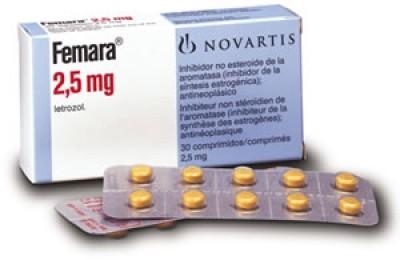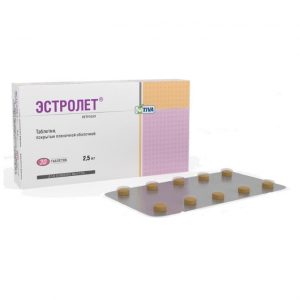Description
Latin name
FEMARA ®
Release form
Film-coated tablets.
Packaging
In a blister pack of 10 tablets. In a cardboard box 3 blisters.
Pharmacological action
Pharmacodynamics
Antitumor drug. It has an antiestrogenic effect, selectively inhibits aromatase (an estrogen synthesis enzyme) by highly specific competitive binding to the subunit of this enzyme, the cytochrome P450 heme. It blocks the synthesis of estrogen in both peripheral and tumor tissues.
In postmenopausal women, estrogens are formed mainly with the participation of the aromatase enzyme, which converts the androgens synthesized in the adrenal glands (primarily, androstenedione and testosterone) into estrone and estradiol.
Daily intake of letrozole in a daily dose of 0.1-5 mg leads to a decrease in the concentration of estradiol, estrone and estrone sulfate in blood plasma by 75-95% of the initial content. Suppression of estrogen synthesis is maintained throughout treatment.
When using the drug Femara ® in the dose range from 0, 1 to 5 mg of a violation of the synthesis of steroid hormones in the adrenal glands is not observed, the test with ACTH does not reveal violations of the synthesis of aldosterone or cortisol. Additional prescription of glucocorticoids and mineralocorticoids is not required.
Blockade of estrogen biosynthesis does not lead to the accumulation of androgens, which are the precursors of estrogens. While taking Femara, there were no changes in the concentration of luteinizing and follicle-stimulating hormones in the blood plasma, changes in the thyroid gland function, changes in the lipid profile, an increase in the frequency of myocardial infarction and strokes.
During treatment with Femara, the incidence of osteoporosis is slightly increased (6.9% compared to 5.5% in the placebo group). However, the frequency of bone fractures in patients receiving Femara ® does not differ from that in healthy people of the same age.
Femara adjuvant therapy of early stages of breast cancer reduces the risk of progression, increases survival without signs of disease for 5 years, reduces the risk of developing a tumor of another breast.
Extended adjuvant therapy with Femara reduces the risk of progression by 42%. A significant advantage in survival without signs of disease in the Femara group was noted regardless of the involvement of the lymph nodes. Treatment with Femara ® reduces mortality among patients with lymph node involvement by 40%.
Pharmacokinetics
Absorption
Letrozole is rapidly and completely absorbed from the digestive tract (average bioavailability is 99.9%). Eating slightly reduces the rate of absorption. The average Tmax of letrozole in the blood is 1 hour when taking Femara on an empty stomach and 2 hours when taken with food, the average Cmax is 129 ± 20.3 nmol / L when taken on an empty stomach and 98.7 ± 18.6 nmol / L when taken with food, however, the degree of absorption of letrozole (as measured by AUC) does not change. Small changes in the absorption rate are regarded as not having clinical significance, therefore letrozole can be taken regardless of food intake.
Distribution of
The binding of letrozole to plasma proteins is approximately 60% (predominantly with albumin – 55%). The concentration of letrozole in red blood cells is about 80% of its level in blood plasma. The apparent Vd during the equilibrium period is about 1.87 ± 0.47 l / kg. Css is achieved within 2-6 weeks of a daily intake of 2.5 mg. Pharmacokinetics is nonlinear. Cumulation with prolonged use is not noted.
Metabolism
Letrozole is largely metabolized by the isoenzymes CYP3A4 and CYP2A6 to form a pharmacologically inactive carbinol compound.
Excretion
It is excreted mainly by the kidneys in the form of metabolites, to a lesser extent through the intestines. The final T1 / 2 is 48 hours.
Pharmacokinetics in special clinical cases
The pharmacokinetic parameters of letrozole are independent of the patient’s age.
With renal failure, the pharmacokinetic parameters do not change.
With moderate hepatic impairment (Child-Pugh class B), average AUC values, although 37% higher, remain within the range of values observed in individuals without impaired liver function. In patients with cirrhosis of the liver and severely impaired function (class C on the Child-Pugh scale), AUC increases by 95% and T1 / 2 by 187%. However, given the good tolerance of high doses of the drug (5-10 mg / day) in these cases, there is no need to change the dose of letrozole.
Indications
Early stages of breast cancer, whose cells have hormone receptors, in postmenopausal women, as adjuvant therapy for
, early stages of breast cancer in postmenopausal women after completion of standard adjuvant therapy with tamoxifen as an extended adjuvant forms of breast cancer in postmenopausal women (first-line therapy)
common forms of breast cancer in postmenopausal women (natural or bathroom artificially) receiving previous antiestrogen therapy.
Contraindications
Endocrine status characteristic of the reproductive period
pregnancy
lactation (breastfeeding)
children and adolescents under 18
hypersensitivity to letrozole or any other component of the drug.
there is no data on the use of the drug Femara ® in patients with creatinine clearance less than 10 ml / min. Before prescribing Femara to such patients, the ratio between the potential risk and the expected treatment effect should be carefully weighed.
Use during pregnancy and lactation
The drug Femara ® is contraindicated for use during pregnancy and lactation.
During therapy with Femara, given the potential for pregnancy, women in the perimenopausal and early postmenopausal period should use reliable methods of contraception until a stable postmenopausal hormonal level is established.
Composition
1 tablet contains:
Active substances: letrozole 2.5 mg.
Excipients: lactose monohydrate, microcrystalline cellulose, corn starch, sodium carboxymethyl starch, silicon dioxide colloidal, magnesium stearate, hypromellose, talc, macrogol 8000, iron oxide yellow (17268), titanium dioxide.
Dosage and administration of
For adults, the recommended dose of Femara ® is 2.5 mg 1 time / day, daily for a long time.
As an extended adjuvant therapy, treatment should be continued for 5 years (no longer than 5 years).
If signs of disease progression appear, Femara should be discontinued.
In elderly patients, dose adjustment of Femara is not required.
In patients with impaired liver and / or kidney function (CC> 10 ml / min), dose adjustment is not required. However, in severely impaired liver function (Child-Pugh class C), patients should be constantly monitored.
Tablets are taken orally, regardless of food intake.
Side effects of
The frequency of side effects is estimated as follows: very frequent ( 10%)
often ( 1, <10%) sometimes ( 0.1%, <1%) rarely ( 0, 01, <0.1%) is very rare (<0.01%, including single messages). As a rule, adverse reactions were mild or moderate and were mainly associated with suppression of estrogen synthesis. From the digestive system: often – nausea, vomiting, dyspepsia, constipation, diarrhea, sometimes – abdominal pain, stomatitis, dry mouth, increased activity of liver enzymes. From the side of the central nervous system and peripheral nervous system: often headache, dizziness, depression, sometimes anxiety, nervousness, irritability, drowsiness, insomnia, memory impairment, dysesthesia, paresthesia, hypesthesia, taste disturbance, episodes of cerebrovascular accident. From the hemopoietic system: sometimes – leukopenia. From the cardiovascular system: sometimes – palpitations, tachycardia, thrombophlebitis of superficial and deep veins, increased blood pressure, IHD (angina pectoris, myocardial infarction, heart failure), rarely thromboembolism – pulmonary embolism, arterial thrombosis, stroke. From the respiratory system: sometimes – shortness of breath, cough. Dermatological reactions: often – alopecia, excessive sweating, skin rash (including erythematous, maculopapular, vesicular rash, psoriasis-like rash) sometimes – itching, dry skin, urticaria, very rarely – angioedema, anaphylactic reaction. From the musculoskeletal system: very often – arthralgia often – myalgia, bone pain, osteoporosis, bone fractures sometimes – arthritis. On the part of the sensory organs: sometimes – cataracts, eye irritation, blurred vision, impaired taste sensations. From the urinary system: sometimes – frequent urination, urinary tract infections. From the reproductive system: sometimes – vaginal bleeding, vaginal discharge, vaginal dryness, pain in the mammary glands. Other: Ptsvery often – paroxysmal sensations of heat (hot flashes) often – increased fatigue, asthenia, malaise, peripheral edema, weight gain, hypercholesterolemia, anorexia, increased appetite, sometimes – weight loss, thirst, hyperthermia (pyrexia), dry mucous membranes, generalized edema pain in the tumor foci. overdose There are some reports of overdose with Femar ®. Treatment: No specific treatment for overdose is known. Symptomatic and supportive therapy is shown. Letrozole is excreted from plasma during hemodialysis. Storage conditions Store in a dry place inaccessible to children at a temperature not exceeding 30 ° C. Expiration 5 years. pharmacy terms for dosage form dosage form tablets Novartis Farma Stein AG, Switzerland



